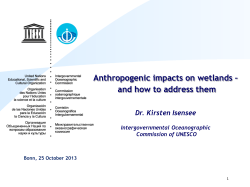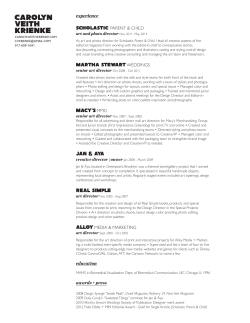
Document 156180
The Earth has one big ocean with many features. The ocean is the dominant physical feature on our planet Earth—covering approximately 70% of the planet’s surface. There is one ocean with many ocean basins, such as the North Pacific, South Pacific, North Atlantic, South Atlantic, Indian and Arctic. DID YOU KNOW? • The ocean is connected to major lakes, watersheds and waterways because all major watersheds on Earth drain to the ocean. So no matter where you live you are connected to world’s one, large global ocean! • Although the ocean is large, it is finite and resources are limited. Credit: NASA Credit: NASA images by Reto Stöckli. Bathymetry images are derived from the General Bathymetric Chart of the Oceans Digital Atlas The ocean and life in the ocean shape the features of the Earth. Many earth materials and geochemical cycles originate in the ocean. Many of the sedimentary rocks now exposed on land were formed in the ocean. DID YOU KNOW? • Sand consists of tiny bits of animals, plants, rocks and minerals. Most beach sand is eroded from land sources and carried to the coast by rivers, but sand is also eroded from coastal sources by surf. Sand is redistributed by waves and coastal currents seasonally. • Sea level changes over time have expanded and contracted continental shelves, created and destroyed inland seas, and shaped the surface of the land. • The Great Lakes are an example of an inland sea that has been shaped over 3 billion years of erosion, flooding by marine seas, sedimentation and glaciers. Photo: Robert Schwemmer, Channel Islands National Marine Sanctuary Photo: Lars Fackler Great Lakes from Space. Credit: Provided by the SeaWiFS Project, NASA/Goddard Space Flight Center, and ORBIMAGE. Map of Great Lakes Basin. Credit: Wikipedia The ocean is a major influence on weather and climate. The ocean controls weather and climate by dominating the Earth’s energy, water and carbon systems. DID YOU KNOW? • The ocean dominates the Earth’s carbon cycle. Half the primary productivity on Earth takes place in the sunlit layers of the ocean and the ocean absorbs roughly half of all carbon dioxide added to the atmosphere. • Since the ocean is a major influence on climate it plays a key role in the amount of rainfall an area has. The reasons the world has areas that have more or less rainfall are partially influenced by the ocean. • Most rain that falls on land originally evaporated from the tropical ocean. Photo: Abe123 The ocean is part of the hydrology cycle. Photo: Associated Press Flooding in Pakistan is influenced by the ocean. Satellite Photo: NOAA A satellite image of Hurricane Katrina in the Gulf of Mexico on August 28, 2005 when it was a Category 5 Hurricane. Where is the rainiest place on Earth? The wettest place in the world is Tutunendo, Colombia, with an average rainfall of 463.4 inches (1177 centimeters) per year. The place that has the most rainy days per year is Mount Wai-'ale'ale on the island of Kauai, Hawaii. It has up to 350 rainy days annually. In contrast, the longest rainless period in the world was14years, from October 1903 to January 1918, at Arica, Chile. In the United States the longest dry spell was 767 days at Bagdad, California—from October 3, 1912, to November 8, 1914. Sources: The Guinness Book of Records 1996, p 64; Williams, Jack, The Weather Book, p. 89. NOAA’s Climate Prediction Center: Average precipitation (rainfall) from September 21-28, 2011 (7 days). Credit: NOAA National Weather Service, Climate Prediction Center The ocean makes Earth habitable. Algae in the ocean produce more of the Earth’s vital oxygen than all of the forests and land plants combined. DID YOU KNOW? • The first life is thought to have started in the ocean. The earliest evidence of life is found in the ocean. • There is evidence that the first living organism was primitive bacteria-like organisms that lived 3,850 million years ago. A tube sponge: Chemical traces suggest sponges were the first animal life on Earth 635 million years ago. Photo: Corbis Photo: Christopher Mueller Photography Grassy field ecosystem. Credit: Ian Britton, Freefoto.com Tropical rainforest ecosystem. Credit: My88KeysinLove Which ecosystem produces the most oxygen? Kelp forest ecosystem. Credit: Claire Fackler, NOAA National Marine SAnctuaries Coral reef ecosystem. Credit: Claire Fackler, NOAA National Marine SAnctuaries The ocean supports a great diversity of life and ecosystems. Ocean life ranges in size from the smallest virus to the largest animal that has lived on Earth, the blue whale. DID YOU KNOW? • The ocean is three-dimensional, offering vast living space and diverse habitats from the surface through the water column to the sea floor. Most of the living space on Earth is in the ocean. Photo: Michael Richlen A large whale, like this killer whale or orca, is a top predator in the ocean. Photo: Dr. Linda Amaral Zettler Copyright: image used under license to MBL (microscope) The acantharians are one of the four types of large amoebae that occur in marine open waters. Photo: © Jim Knowlton This colorful photo depicts the biodiversity of a rocky reef in Channel Islands National Marine Sanctuary. Credit: James Watt Ocean habitats are defined by environmental factors, such as salinity, temperature and dissolved oxygen. Credit: Greg McFall, NOAA National Marine Sanctuaries Credit: Steve Sellers Credit: Florida Keys National Marine Sanctuary Credit: Cordell Bank National Marine Sanctuary The ocean and humans are inextricably interconnected. DID YOU KNOW? • Much of the world’s population lives in coastal areas. The ocean affects every human life. It supplies fresh water (most rain comes from the ocean) and nearly all Earth’s oxygen. It moderates the Earth’s climate, influences our weather, and affects human health. • From the ocean we get food, medicines, and mineral and energy resources. In addition, it provides jobs, supports our nation’s economy, serves as a highway for transportation of goods and people, and plays a role in national security. • The single greatest source of ocean pollution is runoff from yards, pavement and farms. Photo: Xinhua News Agency/Associated Press Thousands of people packed a beach to avoid summer heat in Dalian, Liaoning Province, China. Photo: © Wolcott Henry, Marine Photo Bank Fisherman catch bait fish with a throw net in Fernando De Noronha in Brazil. Photo: United States Coast Guard Fire boat response crews battle the blazing remnants of the off shore oil rig Deepwater Horizon on April 21, 2010 in the Gulf of Mexico in the United States. Credit: Marcia Moreno-Baez Global Ocean Issues: • Marine debris and plastic pollution • Overfishing • Climate Change and Ocean Acidification Credit: Claire Fackler, NOAA National Marine Sanctuaries • Water Pollution Credit: Guy Marcovaldi The ocean is largely unexplored. DID YOU KNOW? • The ocean covers two-thirds of planet Earth, yet we know more about the moon’s surface than the deep ocean. The ocean is the last and largest unexplored place on Earth—less than 5% of it has been explored. This is the great frontier for the next generation’s explorers and researchers, where they will find great opportunities for inquiry and investigation. Photo: Kevin Raskoff, NOAA Ocean Exploration This Chrysaora jelly was spotted on an ROV’s return to the surface during a NOAA expedition to the Arctic in 2002. It was too large to capture with the suction sampler. Photo: Harbor Branch Oceanographic Institution Scientists have maximum visibility in the Johnson-Sea-Link submersible’s acrylic sphere. • The deepest anyone has ever gone in the ocean was in 1960, when U.S. Navy lieutenant, Don Walsh and Swiss oceanographer Jacques Piccard went to a depth of 35,800 feet in the “bathyscaphe” Trieste. This is the deepest place in the ocean. It is known as the Challenger Deep in the Mariana Trench off Guam. Photo: Tin-Yam Chan (national Taiwan Ocean University, Keelung This blind lobster with bizarre chelipeds was collected at 300 meters and is a new species discovered during the Census of Marine Life. Credit: Monika Bright, University of Vienna, Austria The giant tube worm from the hydrothermal vents at the East Pacific Rise at 2,500 meters (8,250 feet) depth. Each individual worm in the photo is larger than one meter (3.3 feet) in length. Credit: Tom Pierce The Exploration Vessel Nautilus - a brand new ship of exploration that will allow at-home explorers to witness its every move on the Internet through a continuous satellite link. Deep-sea Hydrothermal Vents In 1977, scientists made a stunning discovery on the bottom of the Pacific Ocean that forever changed our understanding of planet Earth and life on it. They found seafloor vents gushing shimmering, warm, mineral-rich fluids into the cold, dark depths. And, to their complete surprise, they found that then vents were brimming with extraordinary, unexpected life. Text courtesy of Woods Hole Oceanographic Institution
© Copyright 2025





















